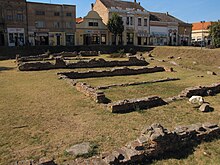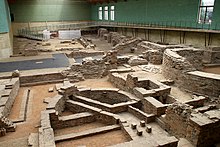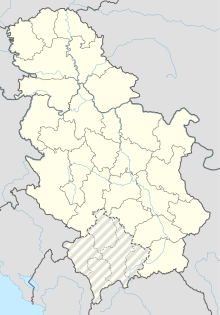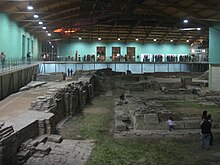Sirmium
Coordinates: 44 ° 59 ′ N , 19 ° 37 ′ E
Sirmium ( Greek Σίρμιον Sirmion ) was an important city on the Balkan Peninsula . It was the capital of the Roman provinces of Pannonia inferior , later Pannonia secunda , center of the prefecture of Illyricum and seat of the bishops of Sirmium . The historical landscape of Syrmia between the Save and Danuvius ( Danube ) was named after this ancient city. The site is located in today's town of Sremska Mitrovica , which belongs to the Serbian Vojvodina .
development
Sirmium was a Celtic , later Illyrian settlement.
It was conquered by the Romans after the Pannonian uprising , around 14 AD, and belonged to the province of Pannonia . The city developed into an important transport hub and economic center during Roman rule. The city's favorable geographical location soon made it very important. It was on the left bank of the Save and about 70 km from Singidunum ( Belgrade ). From Italy one could quickly reach Singidunum and the eastern provinces of the empire via Sirmium , as the Danube ( Danuvius ), the most important traffic route between east and west, was easy to reach via the Save . Dalmatia , located south of the Danube, was also easy to travel from there. Among the Flavians , Sirmium received the status of a colonia and thus the name Colonia Flavia Sirmium .
After the division of the province of Pannonia under Emperor Trajan , Sirmium was the capital of the eastern part from 103, Pannonia inferior . Emperor Mark Aurel moved into one of his headquarters here during the Marcomann Wars .
In the crisis time of the soldier emperors (3rd century), Sirmium also played an important role, as some usurpations began from here. Some emperors grew up in their area, came from the city itself, or temporarily set up their residence here:
One ruler even spent most of his life in Sirmium , Claudius II Gothicus . In 236 the city was the starting point of the campaign of Emperor Maximinus Thrax against the Sarmatians . In 296 it became the capital of the newly created province of Pannonia secunda . During the reign of Emperor Diocletian , Galerius , Licinius and Constantine was Sirmium imperial residence . and was then one of the four capitals of the Roman Empire.
Bishops of Sirmium have been known since 304 . The four Synods of Sirmium (351–359) also took place in the Imperial Palace .
middle Ages
Sirmium was on the border between East and West Rom. After the Romans, the rulers of the strategically important city changed several times: in 441 or 442 it was conquered by the Huns. From 504 the Ostrogoths ruled Sirmium. After the end of the Gothic rule it was under the control of the Gepids and was their capital. After the destruction of the Gepid Empire in 567 by the Longobards, Sirmium fell to the Eastern Roman Empire , which reached its greatest extent on the eve of the Longobard invasion of Italy. In 582 the Avars conquered Sirmium. In 870 Pope Hadrian II made Sirmium the seat of the Archbishop of Pannonia and Greater Moravia . The actual bishopric, however, was Mosapurc in the Balaton Principality , since Sirmium belonged to the Greater Bulgarian Empire at that time . In 1020 the Byzantines recaptured the city, which with a few interruptions remained Byzantine until the end of the 12th century. Since 1180, Syrmia has come under Hungarian rule, with the Serbian influence in the region increasing in the period that followed (cf. especially the spread of Serbian rule in the 13th and 14th centuries , as well as information on the successor town of Sremska Mitrovica ). During the Ottoman rule (from 1526) the city lost its importance.
Archaeological exploration
In 1960, a Yugoslav-French team of archaeologists led by Noël Duval, Đurđe Bošković and Vladislav Popović began to research the material evidence of the Roman era and to secure the excavated remains of the Roman buildings. In the Sirmium series . Archaeological investigations in Syrmian Pannonia , the research results were published by the Archaeological Institute in Belgrade and the École Française in Rome. As a result of the collapse of the Socialist Federal Republic of Yugoslavia in 1991/1992, the excavations were not continued until further notice.
literature
- Sirmium. Archaeological investigations in Syrmian Pannonia. Published by the Arheološki Institute, Belgrade, and the École Française, Rome. 12 volumes, 1971–1982 (publication of the excavation results of the Yugoslav-French archaeological team).
- Bora Čekerinac: Sirmium - Sremska Mitrovica. Illustrated chronology from prehistory to the beginning of the 21st century . Museum of Srem, Sremska Mitrovica 2011, ISBN 978-86-86109-08-8 .
- Michael Durst : Sirmium . In: Lexicon for Theology and Church . 3rd edition, Volume 9: San to Thomas. Herder, Freiburg 2000, Col. 632-634.
- Noël Duval: Sirmium. Ville impériale ou Capitale? In: XXVI corso di cultura sull'arte Ravennate e bizantina. Volume 26, 1979, pp. 53-90.
- Miroslav Jeremić: The Sirmium Imperial Palace Complex, in Light of the Recent Archaeological investigations . In: Nenad Cambi (ed.): Dioklecijan, tetrarhija i Dioklecijanova palača o 1700. obljetnici postojanja . Književni Krug, Split 2009, ISBN 978-953-163318-5 , pp. 471–497.
- Wendelin Kellner: A Roman coin find from Sirmium (Gallienus – Probus) (= memoranda of the Austrian Academy of Sciences, Philosophical-Historical Class. Volume 133; at the same time = publications of the Numismatics Commission. Volume 7; also = Thesaurus nummorum Romanorum et Byzantinorum. Volume 2). Austrian Academy of Sciences, Vienna 1978, ISBN 3-7001-0256-9 .
- Arnulf Kollautz: People's movement on the lower and middle Danube in the period from 558/562 to 582 (fall of Sirmium) . In: Journal for East Research. Volume 18, 1979, pp. 448-489.
- Myrna Kostash: Prodigal Daughter. A Journey to Byzantium . University of Alberta, Edmonton 2010, ISBN 978-0-88864-534-0 , pp. 151-157.
- Miroslava Mirković, Anka Milos̆ević, Vladislav Popović: Sirmium - Its history from the 1st century AD to 582 AD . Belgrade 1971.
- Miroslava Mirković: Sirmium. Istorija rimskog grada od I do kraja VI veka . Alta Nova, Belgrad-Zemun 2006, ISBN 86-84457-04-8 (Serbian; German translation of the book title: Sirmium. History of the Roman city from the 1st to the 6th century ).
- Günther Moosbauer: The forgotten Roman battle. The sensational find on the Harzhorn. CH Beck, Munich 2018, ISBN 978-3-406-72489-3 .
- András Mócsy: The population of Pannonia up to the Marcomann Wars . Akadémiai Kiadó, Budapest 1959.
- Ivana Popović: Sirmium (Sremska Mitrovica) - residence of the Roman emperors and site of the early Christians . In: Ulrich Brandl, Miloje Vasić (ed.): Rome's legacy in the Balkans. Late antique imperial villas and city complexes in Serbia . von Zabern, Mainz 2007, ISBN 978-3-8053-3760-1 , pp. 17–32.
- Vladislav Popović: Sirmium, ville impériale . In: Files of the VII International Congress on Christian Archeology. Trier, 5th-11th September 1965 . Pontificio istituto di archeologia cristiana, Città del Vaticano 1969, Volume 1, pp. 665-675.
- Dragoslav Srejović (Ed.): Roman imperial towns and palaces in Serbia. Sirmium, Romuliana, Naissus (= Gallery of the Serbian Acadademy of Sciences and Arts / Galerija Srpske Akademije Nauka i Umetnosti. Volume 73). Belgrade 1993 (exhibition catalog, including the essay p. 15–27 on Sirmium and the catalog entries on the architectural findings on pp. 89–117).
- Michael Werner: Sirmium. Imperial palace complex . Zavod za Zaštitu Spomenika Kulture, Sremska Mitrovica 2010, ISBN 978-86-906655-6-3 .
Footnotes
- ↑ Bora Čekerinac: Sirmium - Sremska Mitrovica . Museum of Srem, Sremska Mitrovica 2011. p. 15.
- ^ Achim Lichtenberger: Severus Pius Augustus. Studies on the sacred representation and reception of the rule of Septimius Severus and his family (193-211 AD) . Brill, Leiden 2011. ISBN 978-900-420-192-7 . P. 156.
- ^ Rajko Bratož: Pannonia . In: Reallexikon der Germanischen Altertumskunde , 2nd edition, Vol. 22: Östgötalag - Pfalz and Pfalzen . de Gruyter, Berlin 2003. pp. 469-483.
- ↑ Pedro Barceló : The Roman Empire in the Religious Change of Late Antiquity. Emperor and bishops in conflict . Verlag Friedrich Pustet, Regensburg 2013, ISBN 978-3-7917-2529-1 , p. 31.
- ↑ Ivana Popović: Sirmium (Sremska Mitrovica) - residence of the Roman emperors and site of the early Christians . In: Ulrich Brandl, Miloje Vasić (ed.): Rome's legacy in the Balkans. Late antique imperial villas and city complexes in Serbia . von Zabern, Mainz 2007. pp. 17–32.
- ↑ General Directorate for Cultural Heritage Rhineland-Palatinate, Landesarchäologie Mainz: SIRMIUM, Sremska Mitrovica (Pannonia inferior) , accessed on May 6, 2014, Moosbauer 2018, p. 123.
- ↑ Bora Čekerinac: Sirmium - Sremska Mitrovica . Museum of Srem, Sremska Mitrovica 2011. p. 25.
- ↑ Klaus Rosen : Attila. The horror of the world . CH Beck, Munich 2016, ISBN 978-3-406-69030-3 , p. 122.
- ↑ Arnulf Kollautz: peoples motion at the lower and middle Danube in the period from 558/562 to 582 (the case of Sirmium) . In: Zeitschrift für Ostforschung, Vol. 18 (1979), pp. 448-489.
- ↑ Friedrich Lotter: Displacements of peoples in the Eastern Alps-Central Danube region between antiquity and the Middle Ages (375–600) . de Gruyter, Berlin 2003. ISBN 3-11-017855-9 . P. 30.
- ↑ Walter Pohl: The Avars. A steppe people in Central Europe 567 - 822 AD. CH Beck, Munich, 2nd edition 2002. ISBN 3-406-48969-9 . Therein chap. 3.4: The conquest of Sirmium (pp. 70–76).
- ↑ Bora Čekerinac: Sirmium -Sremska Mitrovica . Museum of Srem, Sremska Mitrovica 2011. pp. 103–111.





